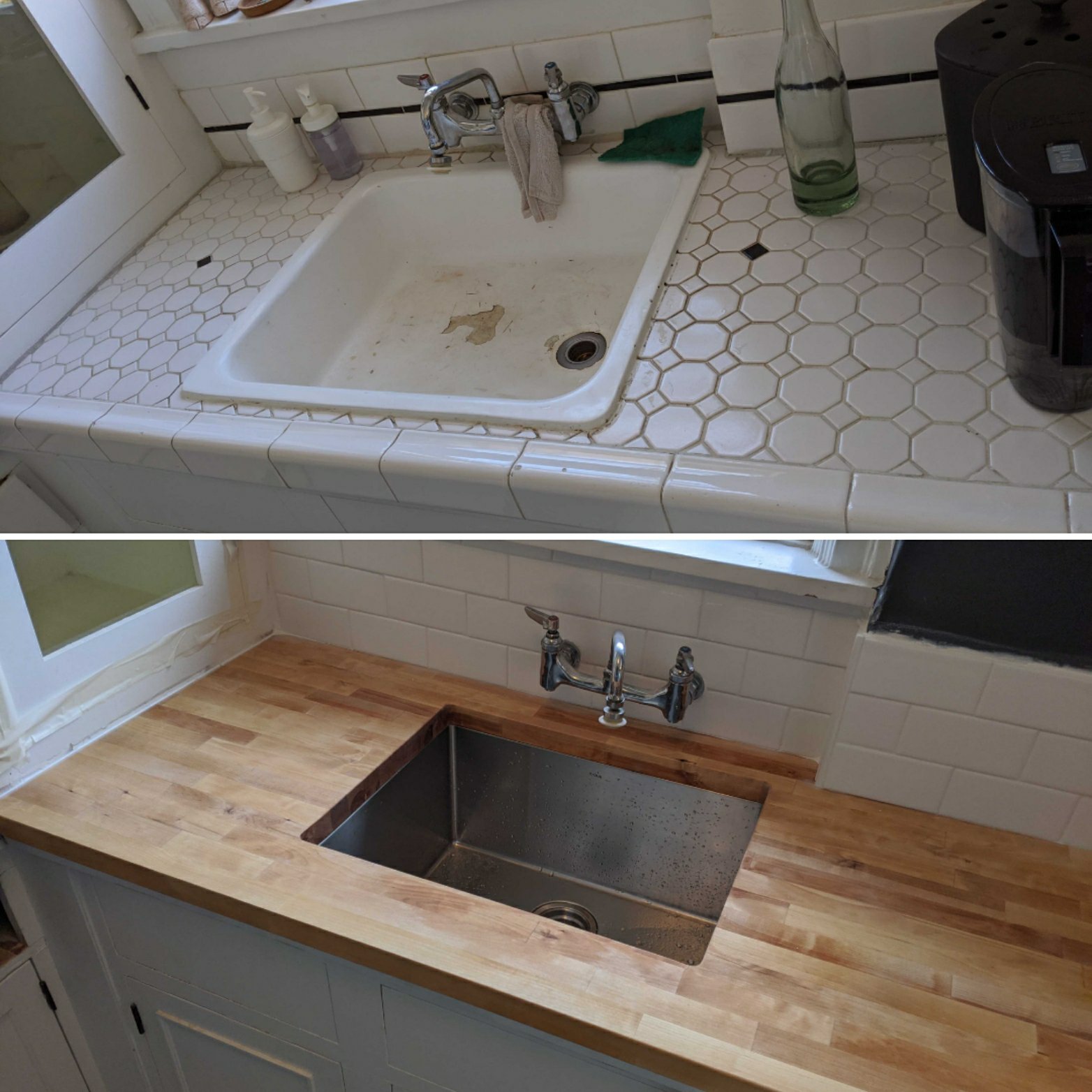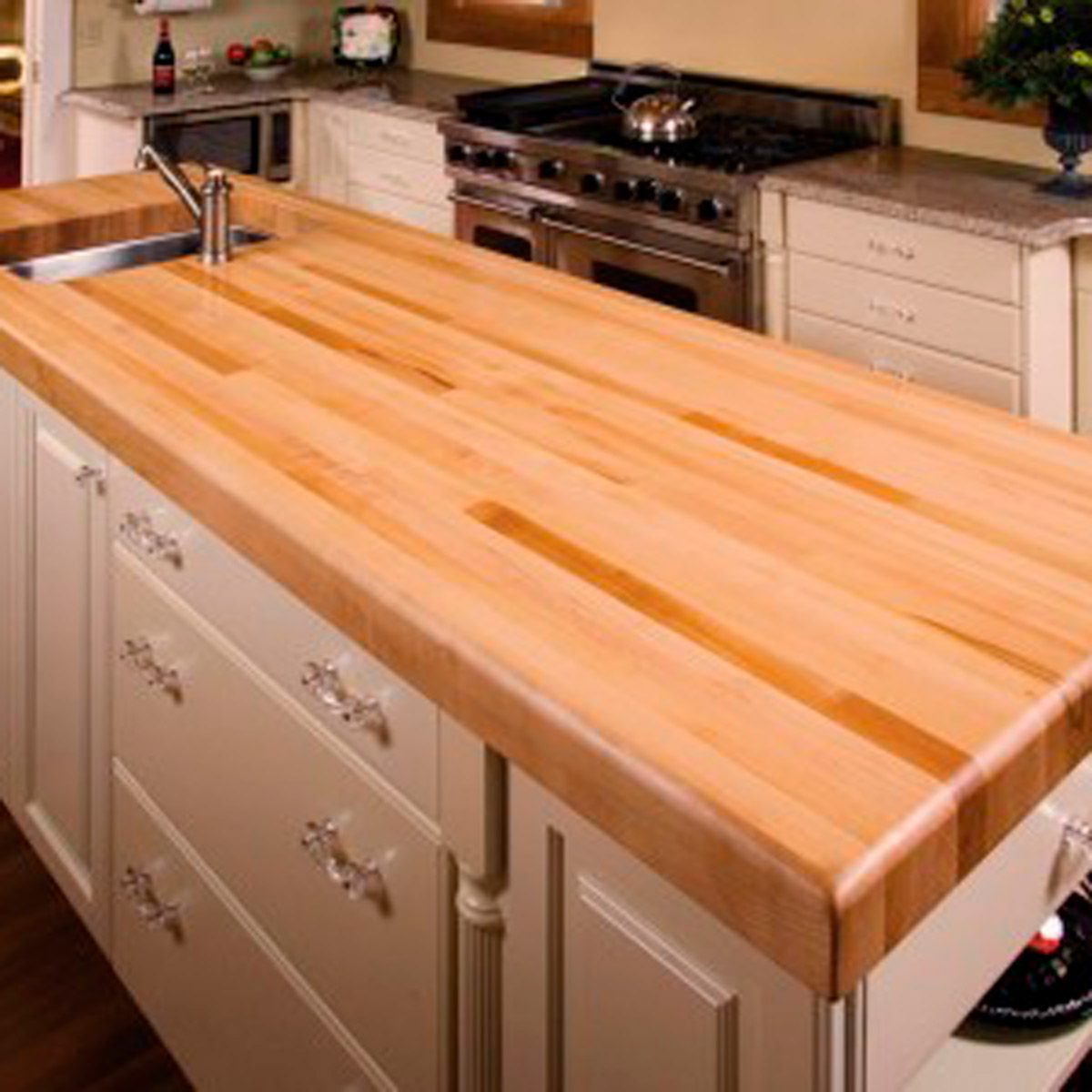Embark on a journey into the world of butcher block countertop installation, where beauty and functionality seamlessly intertwine. This guide unveils the secrets of crafting a stunning and enduring kitchen centerpiece, providing a comprehensive overview of materials, methods, maintenance, and design considerations.
Butcher Block Countertop Materials

Butcher block countertops are a popular choice for kitchens due to their durability, beauty, and warmth. They are made from a variety of wood species, each with its own unique characteristics. Some of the most common types of butcher block countertops include:
- Maple: Maple is a light-colored wood with a fine grain. It is durable and easy to maintain, making it a good choice for families with children or pets.
- Cherry: Cherry is a reddish-brown wood with a rich grain. It is slightly softer than maple, but still very durable. Cherry countertops will darken over time, giving them a beautiful patina.
- Walnut: Walnut is a dark brown wood with a dramatic grain. It is very durable and resistant to scratches and dents. Walnut countertops are a good choice for those who want a unique and stylish look.
- Teak: Teak is a golden-brown wood with a natural resistance to water and rot. It is a very durable wood, making it a good choice for outdoor kitchens or areas with high humidity.
In addition to the wood species, butcher block countertops can also be finished in a variety of ways. Some of the most common finishes include:
- Oil: Oil finishes are the most common type of finish for butcher block countertops. They are easy to apply and maintain, and they help to protect the wood from water and stains.
- Polyurethane: Polyurethane finishes are more durable than oil finishes, but they can be more difficult to apply and maintain. They also tend to give the wood a more plastic-like appearance.
- Epoxy: Epoxy finishes are the most durable type of finish for butcher block countertops. They are waterproof and resistant to scratches and dents. However, they can be difficult to apply and can be expensive.
The type of butcher block countertop material and finish you choose will depend on your individual needs and preferences. Consider the following factors when making your decision:
- Durability: How durable do you need the countertop to be? If you have a family with children or pets, you will need a more durable countertop than someone who lives alone.
- Maintenance: How much maintenance are you willing to do? Oil finishes are easy to maintain, while polyurethane and epoxy finishes require more care.
- Price: Butcher block countertops can vary in price depending on the type of wood and finish you choose. Be sure to factor in the cost of installation when budgeting for your new countertop.
The following table compares the durability, maintenance requirements, and price range of each type of butcher block countertop material:
| Material | Durability | Maintenance | Price Range |
|---|---|---|---|
| Maple | Good | Easy | $50-$100 per square foot |
| Cherry | Good | Easy | $75-$150 per square foot |
| Walnut | Excellent | Moderate | $100-$200 per square foot |
| Teak | Excellent | Difficult | $150-$300 per square foot |
Butcher Block Countertop Installation Methods

Installing a butcher block countertop requires careful planning and execution. There are several installation methods to choose from, each with its advantages and disadvantages.
The most common installation methods are face-framing, under-mounting, and self-rimming. The choice of method depends on the type of countertop, the cabinetry, and the desired aesthetic.
Face-Framing
In face-framing installation, the butcher block countertop is attached to a frame that is mounted to the face of the cabinets. This method is relatively easy to install and provides a traditional look.
Materials and Tools Required:
- Butcher block countertop
- Face-frame lumber
- Wood screws
- Drill
- Countersink bit
Steps:
- Measure and cut the face-frame lumber to fit the perimeter of the cabinets.
- Attach the face-frame lumber to the face of the cabinets using wood screws.
- Set the butcher block countertop on top of the face-frame and secure it with wood screws.
- Countersink the screws and fill the holes with wood filler.
Butcher Block Countertop Maintenance and Care

Maintaining the beauty and longevity of butcher block countertops requires proper cleaning and care. Understanding the specific needs of different materials is crucial for effective maintenance.
To preserve the natural warmth and character of butcher block countertops, follow these general guidelines:
Cleaning Solutions
- Soap and Water:For daily cleaning, use a mild dish soap and warm water. Avoid harsh detergents or abrasive cleaners.
- White Vinegar:Dilute white vinegar with water (1:1 ratio) for occasional deep cleaning. Vinegar’s acidity helps remove stains and disinfect the surface.
- Mineral Oil:Regularly apply mineral oil to protect the wood from moisture and enhance its natural luster.
Frequency
- Daily:Wipe down the countertop with a damp cloth after use.
- Weekly:Clean the surface thoroughly with a soap and water solution.
- Monthly:Apply mineral oil to nourish the wood.
Special Care Considerations
- Oiled Surfaces:Oiled countertops require regular oiling to maintain their protective layer. Avoid using wax or polyurethane, as they can seal the surface and prevent oil penetration.
- Lacquered Surfaces:Lacquered countertops have a protective coating that resists stains and moisture. Clean with a mild soap and water solution and avoid using abrasive cleaners.
- Unfinished Surfaces:Unfinished countertops are more susceptible to stains and moisture damage. Protect them by applying a food-safe sealant or oil.
Butcher Block Countertop Design Considerations
Incorporating butcher block countertops into your kitchen design requires careful consideration of various factors to achieve a cohesive and visually appealing space. The following tips will guide you in creating a butcher block countertop that seamlessly complements your kitchen’s style and layout.
Kitchen Style and Layout
Butcher block countertops can enhance a wide range of kitchen styles, from traditional to modern. For classic kitchens, choose a warm-toned butcher block with a rich grain pattern to create a cozy and inviting atmosphere. In contemporary kitchens, opt for a lighter-colored butcher block with a more subtle grain to complement sleek cabinetry and appliances.
The layout of your kitchen also influences the design of your butcher block countertop. In kitchens with an island, consider using butcher block for both the island and the perimeter countertops to create a cohesive look. In smaller kitchens, a butcher block countertop on the island or a single wall can add warmth and character without overwhelming the space.
Cabinetry and Flooring, Butcher block countertop installation
The color and finish of your kitchen cabinets and flooring play a significant role in determining the overall aesthetic of your butcher block countertop. For a classic look, pair a dark butcher block countertop with white or cream-colored cabinets and light-colored flooring.
For a more modern look, opt for a light-colored butcher block countertop with dark cabinets and darker flooring.
Consider the grain pattern of your butcher block countertop in relation to the cabinetry and flooring. A butcher block with a bold grain pattern can add visual interest to a kitchen with simple cabinetry and flooring, while a butcher block with a more subtle grain can complement more ornate cabinetry and flooring.
Appliances
The style and finish of your kitchen appliances can also influence the design of your butcher block countertop. For a cohesive look, choose appliances that complement the color and finish of your butcher block countertop. For example, stainless steel appliances can complement a butcher block countertop with a warm or cool tone.
If you have a large kitchen with multiple appliances, consider using a butcher block countertop on the island or a single wall to avoid overwhelming the space. You can also use butcher block as a backsplash to create a unique and stylish focal point.
Epilogue: Butcher Block Countertop Installation

With careful planning and execution, butcher block countertops can transform your kitchen into a culinary haven. Embrace the warmth and character of natural wood, while enjoying the benefits of durability and ease of maintenance. Whether you’re a seasoned DIY enthusiast or seeking professional guidance, this guide empowers you to create a kitchen masterpiece that will stand the test of time.
